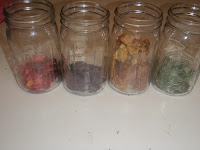 In the fall, the trees turn in their lush green leaves for a
more colorful display. It is always fun
to see the variety from red to yellow, and even some unusual colors like
purple. In today’s activity we are going to gather
leaves during a nature walk and then do a little chemistry to see what pigment
colors really make up that leaf. Is
green the only pigment color in a green leaf or are there more colors that we
can’t even see? This activity takes a
lot of parent involvement and was frankly more fun for me than it was for my
preschoolers, but they still had a good time.
In the fall, the trees turn in their lush green leaves for a
more colorful display. It is always fun
to see the variety from red to yellow, and even some unusual colors like
purple. In today’s activity we are going to gather
leaves during a nature walk and then do a little chemistry to see what pigment
colors really make up that leaf. Is
green the only pigment color in a green leaf or are there more colors that we
can’t even see? This activity takes a
lot of parent involvement and was frankly more fun for me than it was for my
preschoolers, but they still had a good time.
Parent Background
Plants have a green pigment called Chlorophyll that captures
the light energy from the sun and uses that energy to form sugars. These sugars are the basis of all of our food
supply, because they are the energy source for the plant and all the animals
that feed on the plant. The Chlorophyll
is so abundant in leaves that most leaves look completely green all
summer. In the fall when the
temperatures start to cool, the days grow shorter and the light from the sun is
less direct trees and other plants begin to shut down their sugar making factory
and the leaves no longer make chlorophyll.
As the leaf starts to die and the chlorophyll fades we get to see some
of the other pigments naturally in the leaves.
These pigments were always there in small amounts and helped the tree to
absorb other wavelengths of light not used by the chlorophyll. However, because they are only present on a
small scale they are only visible once the plentiful green pigment is no longer
present. Today’s experiment uses rubbing
alcohol as a carrier to separate the leaf pigments on a piece of filter paper
so that colors other than those visible in the leaf can be seen. This works because the rubbing alcohol dissolves
the pigments and carries it with them up the paper, the alcohol evaporates
leaving the pigment behind. Each pigment
forms its own line because different colors have different weights and are
carried different distances before the alcohol dissolves.
Materials
 |
| Our Leaves: Red, Purple, Yellow, Green |
Clothes
pins, tape, or paper clips to clip coffee filters to jar
Colored Leaves from a Leaf Walk
(Try to get ones right from the tree or that are still moist and don’t forget
green leaves as well as the fall color leaves)Rubbing Alcohol to fill each jar about 1.5-2 inches
 |
| Ground Up Leaves |
Small food processor, blender, grinder, or hand chopper
Cake pan to use as a hot water bath.
Procedure: Do this
experiment in a well-ventilated area.
1.
Take your
children out to pick fall leaves. Try to
get at least 3 colors making sure to include green. You will need a handful of each color.
2.
Have your children separate leaves into jars
with like colors so each jar only holds one color.
3.
Determine how much rubbing alcohol is required
to fill your jar to the 1.5-2” mark.

4.
Making sure to protect your eyes while grinding the leaves in alcohol. Place leaves and rubbing alcohol in your food
processor, other appliance or grind them by hand making sure to produce small
pieces so that the rubbing alcohol can dissolve the pigment from the
cells.
5.
Pour each alcohol/leaf mixture into a jar and
rinse the bowl before doing the other color.
6.
You will notice the alcohol starting to take on
each leaf color and should ask your children what color the leaves and alcohol
is in each bowl.
7.
Once each bowl or jar is filled with a leaf
mixture, loosely cap, and place it in a hot water bath (just around the bottom)
for 30 minutes to allow the alcohol to pull as much pigment as possible out of
the leaves, turning black is a great sign but mine didn’t quite get there and
still worked great. I poured boiling
water into a glass cake pan around the jars.
8.
Cut Coffee filters into 2 “ strips and write the
name of each leaf color on the strip.
9.
Uncap the jars and lip or tape the strip to the
rim of the jar with the bottom of the strip in the leaf/alcohol mixture.
10.
Wait one hour or more to allow the alcohol to be
absorbed and evaporated from the coffee filter strips. Ask your kids to see what colors they can
find. Our results are below:
 |
| Red Leaves: Red and yellow sections of color. Green Leaves: Yellow Lines, Green Lines Yellow Leaves: Yellow Line, Green Line. Purple Leaves: Purple color throughout, green line, yellow line. |
No comments:
Post a Comment